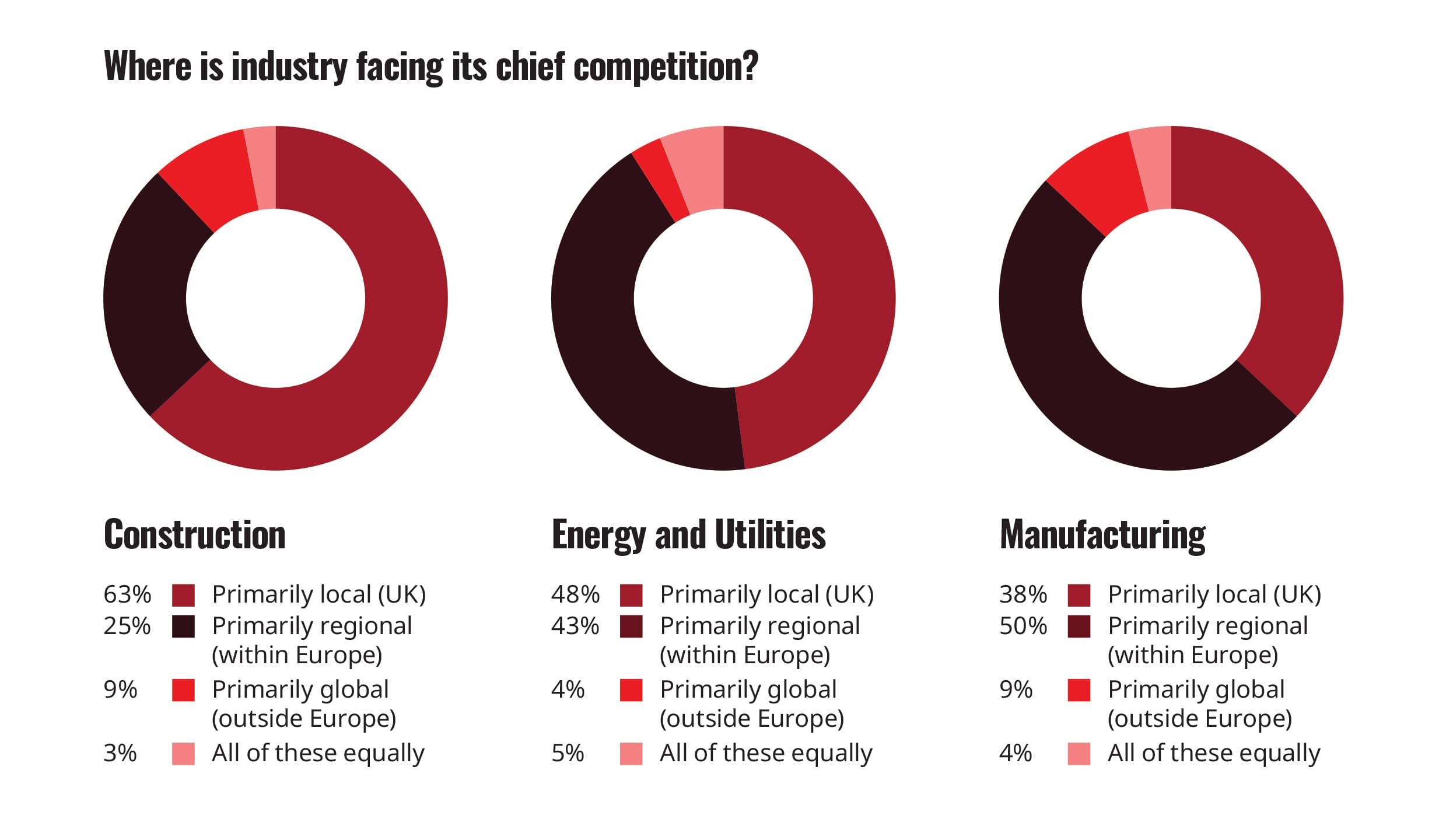- Published 23 Sept 2025
- Last Modified 26 Sept 2025
- 7 min
Powering Progress Through Innovation: Staying Competitive in UK Industry
Innovation is critical for staying competitive in industry. But many in the construction, energy, and manufacturing sectors are finding it difficult to take a proactive, strategic, and always-on approach to innovation. Our in-depth report takes you through a snapshot of the current state of innovation in industry, providing key insights into the pressures, challenges, and opportunities faced.
Foreword by Mike Bray, VP of Innovation at RS

The manufacturing, construction, and energy sectors face accelerating pressures – from economic uncertainty and regulatory shifts to talent shortages and fierce competition. The following report is based on a survey of decision-makers across the UK, France, and Italy. It has been conducted to understand how innovation is helping businesses gain and maintain a competitive edge.
"People are excited by innovation, and there is a strong willingness to act among senior decision makers. But ultimately, execution comes down to culture. Balancing immediate challenges, such as economic uncertainty, regulatory shifts and talent shortages, and creating time and space to think of new and different ideas is a constant challenge. This could be why taking a proactive, strategic and always on approach to innovation remains an aspiration for many."
Mike Bray, VP of Innovation at RS
Executive Summary
In June 2025, RS surveyed 567 industrial sector decision-makers in the UK, France, and Italy. This report focuses on data insights from the 193 respondents in the UK who are senior decision makers working across construction, energy, and manufacturing in the UK. Click here to learn more about the methodology used for the survey and report.
What you will learn from this report:
- Where innovation sits in the list of business imperatives for industrial sectors
- The key drivers behind current innovation efforts
- The main challenges impeding progress
- Where investment is being directed to power further progress
Senior industry leaders are confident about the future, with 90% agreeing that innovation is important to their organisations.
Even so, staying competitive keeps them awake at night. 78% are struggling to align innovation efforts with operational demands. Both internal and external barriers prevent strategic innovation.
Find out how organisations can deal with their biggest headache - maintaining a competitive edge - by adopting a more proactive approach to innovation.
The Competitive Imperative
Competition is a major threat to an organisation’s bottom line, so it’s crucial for decision-makers to know who their main rivals are. For the three sectors, the data from the report suggests that competition is close to home for all three industries, with most major competitors residing either locally (UK) or regionally (Europe). Looking closer, both the construction (63%) and energy (48%) industries are mostly seeing this competition locally whilst the manufacturing industry (50%) is experiencing more across mainland Europe.

Innovation the key?
With strong domestic and regional competition posing challenges to decision-makers, the importance of innovation to the respondents was clear. When asked how important innovation is to their ‘ability to remain or become competitive’ against their main rivals, there was strong agreement across all three sectors (100% of manufacturers agree, compared with 97% in construction and 95% in energy). Based on these results, it’s clear to see that business leaders are treating innovation as a major factor in fighting off competition and staying ahead of the curve.
The Top Innovation Drivers
It’s clear to see that innovation is important to UK industry, but what are the primary motivations for driving it in the three sectors? When it comes to staying ahead of the competition, growth and revenue top the list of key motivators. The top driver for energy is growth and/or profitability, whereas the manufacturing industry leverages innovative solutions to attract new customers. For the construction industry, innovation is predominantly motivated by efforts to increase efficiency and reduce costs. In summary, for each industry the bottom line is a crucial underlying consideration.
Embracing Risks
For innovation to be possible, it’s essential for organisations to foster an environment where experimentation and risk-taking is embraced and encouraged. The participants agreed that their organisation is doing exactly that (94% manufacturing, 91% energy and 87% construction) to support constant improvement.
Adopting a Strategic Approach
Although decision-makers are clear about their motivations for pursuing innovation, their approaches reveal mixed results. Most describe their efforts as "proactive and continuous," but the numbers show otherwise, with manufacturing leading at 62% and construction trailing at 52%. The findings indicate that many organisations still rely on opportunistic or ad-hoc strategies rather than consistently embedding innovation to achieve their goals and overcome challenges.

Laying the Right Technology Foundations
62% of decision-makers rate their infrastructure as 'advanced', indicating cautious confidence in UK industry's technological foundations. Despite this, legacy systems remain a significant barrier, with 82% of leaders acknowledging that they hold organisations back - especially in construction (85%). To modernise, sectors prioritise Industrial IT, seen as crucial in energy (47%) and manufacturing (43%). Perhaps surprisingly, only 34% of participants called AI a current priority.
Navigating Challenges
Both internal and external barriers challenge innovation across industry. Among external concerns, supply chain disruption (41%) and difficult economic conditions (38%) rank highest. While UK businesses face these pressures more acutely than their European counterparts, market volatility is viewed as less challenging (34% in the UK versus 49% in France and 41% in Italy). Organisational silos, cultural inertia, and misaligned leadership hinder innovation internally.
Mike Bray, VP of Innovation at RSCultural resistance – among teams, managers, or frontline staff – can slow the adoption of new tools, technologies, and processes, making it difficult to scale pilots and proof-of-concepts.”
Investing in Components
It is encouraging that organisations continue to invest in modernising cables, wiring, connectors, and test and measurement equipment as part of ongoing improvement programmes. In the next three years, 85% of manufacturing organisations plan to invest in cables and wire components, 88% of energy and utilities organisations are looking to spend on connectors, and 78% of construction companies plan to acquire new test and measurement equipment.
Download the Report

RS - Staying Competitive: Innovation in UK Industry
This in-depth study spotlights industry’s innovation challenges and explores the approaches, technologies, and components that businesses are adopting to survive and thrive.
Methodology
This report is based on a survey conducted by Walnut on behalf of RS in June 2025. Across the UK, France, and Italy, 567 senior decision makers were surveyed . In this report, unless otherwise stated, the findings are based on data from the 193 UK research participants.
UK participants by sector: 68 manufacturing, 67 energy and utilities, and 58 construction.
Job roles by market
Base - All respondents | Total | UK | France | Italy |
|---|---|---|---|---|
| Owner, CEO | 19% | 12% | 23% | 23% |
| C-Suite, Director | 40% | 40% | 44% | 38% |
| Senior management | 32% | 38% | 31% | 26% |
| Mid-level management | 7% | 8% | 1% | 12% |
| Junior management | 1% | 2% | 1% | 2% |
Explore the Components Powering Progress
Components provide essential infrastructure for innovation. Explore the three component groups seeing the highest investment levels from UK industry, according to the report findings.
Cables and Wires
From control and instrumentation to ethernet cable and equipment wire, cables and wires power a diverse range of appliances and electrical equipment. At RS our cables and wires provide end-to-end technical flexibility, quality, convenience, and sustainability.
Connectors
Connectors link components together – from board-to-board and wire-to-board to power and data systems – forming the backbone of electrical and electronic innovation. Our connectors deliver versatility, reliability, efficiency, and resilience.
Test & Measurement
From handheld multimeters and oscilloscopes to precision power analysers and environmental sensors, test and measurement equipment is vital for validating designs, troubleshooting issues, and ensuring product quality. Our test and measurement solutions provide accuracy, reliability, convenience, and scalability.
